Pritzker Prize
| Pritzker Architecture Prize | |
|---|---|
| Awarded for | A living architect whose built work demonstrates a combination of those qualities of talent, vision and commitment, which has produced consistent and significant contributions to humanity and the built environment through the art of architecture |
| First awarded | 1979 |
| Official website | http://www.pritzkerprize.com/ |
The Pritzker Architecture Prize is awarded annually by the Hyatt Foundation to honor "a living architect whose built work demonstrates a combination of those qualities of talent, vision and commitment, which has produced consistent and significant contributions to humanity and the built environment through the art of architecture".[1] Founded in 1979 by Jay A. Pritzker and his wife Cindy, the award is funded by the Pritzker family and is considered to be one of the world's premier architecture prizes; it is often referred to as the Nobel Prize of architecture.[2][3] The prize is awarded "irrespective of nationality, race, creed, or ideology";[4] the recipients receive US$100,000, a citation certificate, and since 1987, a bronze medallion.[5] The Latin inscription on the reverse of the medallion—firmitas, utilitas, venustas (English: durability, utility, and beauty)—is inspired by Roman architect Vitruvius.[6] Before 1987, a limited edition Henry Moore sculpture accompanied the monetary prize.[5]
The Executive Director of the prize, as of 2009, Martha Thorne,[7] solicits nominations from a range of people including past Laureates, academics, critics and others "with expertise and interest in the field of architecture".[4] Any licensed architect can also make a personal application for the prize before 1 November every year. In 1988 Gordon Bunshaft nominated himself for the award and eventually won it.[8] The jury, each year consisting of five to nine "experts ... recognized professionals in their own fields of architecture, business, education, publishing, and culture", deliberate early the following year before announcing the winner in spring.[4]
Inaugural winner Philip Johnson was cited "for 50 years of imagination and vitality embodied in a myriad of museums, theaters, libraries, houses, gardens and corporate structures".[9] The 2004 laureate Zaha Hadid was the first female prize winner.[10] Richard Meier is the youngest winner, being 49 in 1984 at the time of the award.[11] The 34th and most recent winners Kazuyo Sejima and Ryue Nishizawa were cited for "architecture that is simultaneously delicate and powerful, precise and fluid, ingenious but not overly or overtly clever".[12]
Contents |
Laureates
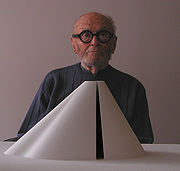

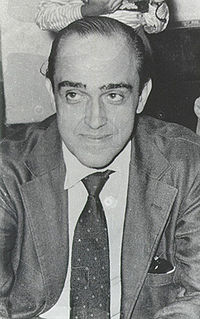
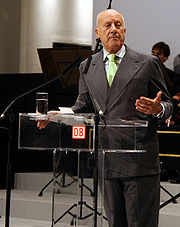
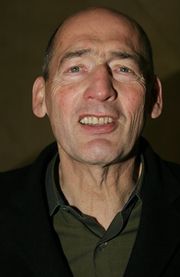

| Year | Laureate | Nationality | Example work (year completed) | Ceremony location | Ref(s) | |
|---|---|---|---|---|---|---|
| 1979 | Philip Johnson |  |
Glass House (1949) | Dumbarton Oaks | [13] | |
| 1980 | Luis Barragán | Torres de Satélite (1957) | Dumbarton Oaks | [3] | ||
| 1981 | Sir James Stirling |  |
Seeley Historical Library (1968) | National Building Museum | [14] | |
| 1982 | Kevin Roche |  |
Knights of Columbus Building (1969) | Art Institute of Chicago | [2][A] | |
| 1983 | Ieoh Ming Pei |  |
National Gallery of Art, East Building (1978) | Metropolitan Museum of Art | [15][16][B] | |
| 1984 | Richard Meier | 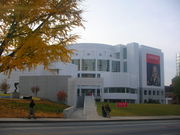 |
High Museum of Art (1983) | National Gallery of Art | [2] | |
| 1985 | Hans Hollein |  |
Abteiberg Museum (1982) | The Huntington Library | [2] | |
| 1986 | Gottfried Böhm |  |
Iglesia Youth Center Library (1968) | Worshipful Company of Goldsmiths | [2] | |
| 1987 | Kenzo Tange |  |
St. Mary's Cathedral, Tokyo (1964) | Kimbell Art Museum | [17] | |
| 1988 | Gordon Bunshaft |  |
Beinecke Rare Book and Manuscript Library (1963) | Art Institute of Chicago | [2] | |
| 1988 | Oscar Niemeyer | Cathedral of Brasília (1958) | Art Institute of Chicago | [2] | ||
| 1989 | Frank Gehry |  |
Walt Disney Concert Hall (1999–2003) | Tōdai-ji | [16][C] | |
| 1990 | Aldo Rossi | 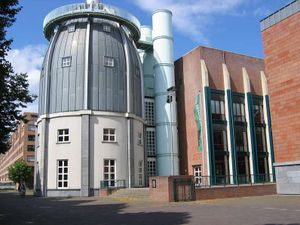 |
Bonnefanten Museum (1990) | Palazzo Grassi | [18] | |
| 1991 | Robert Venturi | 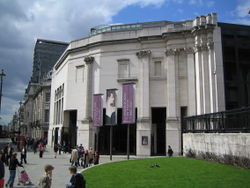 |
National Gallery (London), Sainsbury Wing (1991) | Palacio de Iturbide | [19] | |
| 1992 | Álvaro Siza Vieira | Pavilion of Portugal in Expo'98 (1998) | Harold Washington Library | [20] | ||
| 1993 | Fumihiko Maki |  |
Tokyo Metropolitan Gymnasium (1991) | Prague Castle | [17] | |
| 1994 | Christian de Portzamparc | French Embassy, Berlin (2003) | The Commons, Columbus, Indiana | [21] | ||
| 1995 | Tadao Ando | Nagaragawa Convention Center (1995) | Palace of Versailles | [22] | ||
| 1996 | Rafael Moneo | Kursaal Palace (1999) | Getty Center | [16] | ||
| 1997 | Sverre Fehn |  |
Norwegian Glacier Museum (1991) | Guggenheim Museum Bilbao | [23] | |
| 1998 | Renzo Piano |  |
Kansai International Airport (1994) | White House | [24] | |
| 1999 | Norman Foster |  |
Millennium Bridge (London) (2000) | Altes Museum | [16] | |
| 2000 | Rem Koolhaas | Embassy of the Netherlands in Berlin (2003) | Jerusalem Archaeological Park | [25] | ||
| 2001 | Herzog & de Meuron | 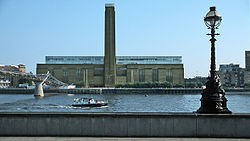 |
Tate Modern (2000) | Monticello | [26] | |
| 2002 | Glenn Murcutt |  |
Berowra Waters Inn (1983) | Michelangelo's Campidoglio | [27] | |
| 2003 | Jørn Utzon |  |
Sydney Opera House (1973) | Royal Academy of Fine Arts of San Fernando | [28] | |
| 2004 | Zaha Hadid | 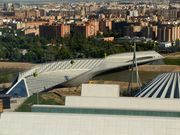 |
Bridge Pavilion (2008) | Hermitage Museum | [16][D] | |
| 2005 | Thom Mayne |  |
San Francisco Federal Building (2007) | Pritzker Pavilion, Millennium Park | [29] | |
| 2006 | Paulo Mendes da Rocha | Estádio Serra Dourada (1975) | Dolmabahçe Palace | [30] | ||
| 2007 | Richard Rogers | 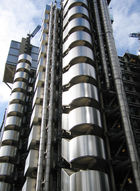 |
Lloyd's building (1986) | Banqueting House, Whitehall | [31] | |
| 2008 | Jean Nouvel |  |
Torre Agbar (2005) | Library of Congress | [16] | |
| 2009 | Peter Zumthor |  |
Therme Vals (1996) | Legislative Palace of the City Council, Buenos Aires | [16] | |
| 2010 | Kazuyo Sejima and Ryue Nishizawa (SANAA) |
21st Century Museum of Contemporary Art, Kanazawa (2003) | Ellis Island | [16] | ||
Footnotes
- A. a Roche was born in Ireland.[32]
- B. b Pei was born in China.[33]
- C. c Gehry was born in Canada.[34]
- D. d Hadid was born in Iraq.[35]
See also
- List of architecture prizes
References
- General
- "Past laureates". Pritzker Prize official site. The Hyatt Foundation. http://www.pritzkerprize.com/laureates/index.html. Retrieved June 30, 2009.
- Specific
- ↑ "The Purpose of the Pritzker Architecture Prize". Pritzker Prize official site. The Hyatt Foundation. http://www.pritzkerprize.com/about/purpose.html. Retrieved June 24, 2009.
- ↑ 2.0 2.1 2.2 2.3 2.4 2.5 2.6 Goldberger, Paul (May 28, 1988). "Architecture View; What Pritzker Winners Tell Us About the Prize". The New York Times. http://www.nytimes.com/1988/05/29/arts/architecture-view-what-pritzker-winners-tell-us-about-the-prize.html. Retrieved June 26, 2009.
- ↑ 3.0 3.1 Endicott, Katherine (October 14, 2006). "The Mexican garden revisited". San Francisco Chronicle. http://www.sfgate.com/cgi-bin/article.cgi?f=/c/a/2006/10/14/HOG51LMROS1.DTL. Retrieved June 26, 2009.
- ↑ 4.0 4.1 4.2 "Nomination Process". Pritzker Prize official site. The Hyatt Foundation. http://www.pritzkerprize.com/about/nomination.html. Retrieved July 3, 2009.
- ↑ 5.0 5.1 "History". Pritzker Prize official site. The Hyatt Foundation. http://www.pritzkerprize.com/about/history.html. Retrieved June 27, 2009.
- ↑ "Ceremony and Medal". Pritzker Prize official site. The Hyatt Foundation. http://www.pritzkerprize.com/about/ceremony.html. Retrieved June 29, 2009.
- ↑ "2009 Jury Members". Pritzker Prize official site. The Hyatt Foundation. http://www.pritzkerprize.com/about/jury.html. Retrieved July 3, 2009.
- ↑ How to win the Pritzker Architecture Prize: Practice, practice, practice (and don't be shy about nominating yourself)
- ↑ "Philip Johnson – 1979 Laureate – Jury Citation". Pritzker Prize official site. The Hyatt Foundation. http://www.pritzkerprize.com/laureates/1979/jury.html. Retrieved June 30, 2009.
- ↑ "Hadid designs landmark building". BBC News. January 15, 2005. http://news.bbc.co.uk/1/hi/england/london/4167077.stm. Retrieved June 29, 2009.
- ↑ "Pritzker Prize 1984 Announcement". The Hyatt Foundation. http://www.pritzkerprize.com/laureates/1984/announcement.html. Retrieved March 30, 2010.
- ↑ "Media Kit: Announcing the 2010 Pritzker Architecture Prize Laureate". The Hyatt Foundation. http://www.pritzkerprize.com/laureates/2010/textmediakit.html. Retrieved March 29, 2010.
- ↑ "People – In the News". Milwaukee Sentinel. Associated Press: p. 2. May 23, 1979. http://news.google.com/newspapers?id=PyMWAAAAIBAJ&sjid=7hEEAAAAIBAJ&pg=6636,4746265&dq=1979+pritzker-prize. Retrieved June 26, 2009.
- ↑ Reynolds, Nigel (March 23, 2004). "Top prize for architect who is ignored by fellow British". Daily Telegraph. http://www.telegraph.co.uk/culture/art/3614334/Top-prize-for-architect-who-is-ignored-by-fellow-British.html. Retrieved June 26, 2009.
- ↑ "The Pritzker Architecture Prize". www.pritzkerprize.com. http://www.pritzkerprize.com/laureates/1983/announcement.html. Retrieved 2009-12-31.
- ↑ 16.0 16.1 16.2 16.3 16.4 16.5 16.6 16.7 Pilkington, Ed (April 14, 2009). "Swiss architect untouched by fad or fashion wins prized Pritzker award". The Guardian. http://www.guardian.co.uk/artanddesign/2009/apr/14/zumthor-pritzker-award. Retrieved June 26, 2009.
- ↑ 17.0 17.1 Muschamp, Herbert (April 26, 1993). "Pritzker Prize for Japanese Architect". The New York Times. http://www.nytimes.com/1993/04/26/arts/pritzker-prize-for-japanese-architect.html. Retrieved June 26, 2009.
- ↑ Iovine, Julie (September 5, 1997). "Aldo Rossi, Architect of Monumental Simplicity, Dies at 66". The New York Times. http://www.nytimes.com/1997/09/05/arts/aldo-rossi-architect-of-monumental-simplicity-dies-at-66.html. Retrieved June 26, 2009.
- ↑ Blau, Eleanor (April 8, 1991). "Robert Venturi Is to Receive Pritzker Architecture Prize". The New York Times. http://www.nytimes.com/1991/04/08/arts/robert-venturi-is-to-receive-pritzker-architecture-prize.html. Retrieved June 26, 2009.
- ↑ Ribeiro, Ana Maria (February 24, 2009). "Siza Vieira fala para casa cheia" (in Portuguese). Correio da Manhã. http://www.correiomanha.pt/noticia.aspx?channelid=00000013-0000-0000-0000-000000000013&contentid=51D599B2-6FC0-4A0A-B423-627068468C6E. Retrieved June 26, 2009.
- ↑ Muschamp, Herbert (May 2, 1994). "Architect of Austere Works Receives the Pritzker Prize". The New York Times. http://www.nytimes.com/1994/05/02/arts/pritzker-prize-goes-to-french-architect-for-the-first-time.html. Retrieved June 26, 2009.
- ↑ Viladas, Pilar (August 19, 2001). "Fashion's New Religion". The New York Times. http://www.nytimes.com/2001/08/19/magazine/fashion-s-new-religion.html. Retrieved June 27, 2009.
- ↑ Samaniego, Fernando (June 1, 1997). "El noruego Sverre Fehn recibe el Pritzker de Arquitectura en el museo Guggenheim Bilbao" (in Spanish). El País. http://www.elpais.com/articulo/cultura/VIZCAYA/BILBAO_/MUNICIPIO/MUSEO_GUGGENHEIM/noruego/Sverre/Fehn/recibe/Pritzker/Arquitectura/museo/Guggenheim/Bilbao/elpepicul/19970601elpepicul_1/Tes/. Retrieved June 26, 2009.
- ↑ Muschamp, Herbert (April 20, 1998). "Renzo Piano Wins Architecture's Top Prize". The New York Times. http://www.nytimes.com/1998/04/20/arts/renzo-piano-wins-architecture-s-top-prize.html. Retrieved June 26, 2009.
- ↑ "Koolhaas receives 'Nobel of architecture' in Jerusalem". CNN. May 29, 2000. http://edition.cnn.com/2000/STYLE/design/05/29/pritzker/. Retrieved June 26, 2009.
- ↑ "Herzog & de Meuron Propose Castle in The Sky for Hamburg". Das Spiegel. June 14, 2005. http://www.spiegel.de/international/0,1518,360341,00.html. Retrieved June 26, 2009.
- ↑ "Top honour for Australian architect". BBC News. April 16, 2002. http://news.bbc.co.uk/2/hi/entertainment/1932366.stm. Retrieved June 26, 2009.
- ↑ "Prize for Opera House designer". BBC News. April 7, 2003. http://news.bbc.co.uk/2/hi/entertainment/2924705.stm. Retrieved June 26, 2009.
- ↑ "Paris skyscraper to rival tower". BBC News. November 28, 2006. http://news.bbc.co.uk/2/hi/europe/6191132.stm. Retrieved June 26, 2009.
- ↑ Forgey, Benjamin (April 9, 2006). "Brazilian wins Pritzker Prize". Washington Post. http://www.washingtonpost.com/wp-dyn/content/article/2006/04/09/AR2006040900934.html. Retrieved June 26, 2009.
- ↑ Glancey, Jonathan (March 29, 2007). "Rogers takes the 'Nobel for architecture'". The Guardian. http://www.guardian.co.uk/society/2007/mar/29/communities.artnews. Retrieved June 26, 2009.
- ↑ "Architecture Award to Kevin Roche". The New York Times. December 14, 1992. http://www.nytimes.com/1992/12/14/arts/architecture-award-to-kevin-roche.html. Retrieved July 26, 2009.
- ↑ Barboza, David (October 9, 2006). "I. M. Pei in China, Revisiting Roots". The New York Times. http://www.nytimes.com/2006/10/09/arts/design/09pei.html. Retrieved June 30, 2009.
- ↑ "Frank O. Gehry. (American, born Canada 1929)". Museum of Modern Art. http://www.moma.org/collection/artist.php?artist_id=2108. Retrieved July 26, 2009.
- ↑ "Zaha Hadid. (British, born Iraq, 1950)". Museum of Modern Art. http://www.moma.org/collection/artist.php?artist_id=2108. Retrieved July 26, 2009.
External links
|
|||||